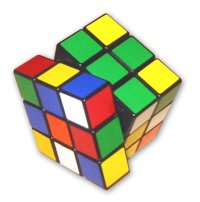
Be creative!
"Ingenuity", "far reaching vision", "unerring sense", "deep curiosity" — and best of all, "extraordinary creativity". These are some of the words that have been used to praise this year's Fields medallists at the International Congress of Mathematicians (ICM). These words aren't specific to maths. They could be used to describe anyone whose work is about discovery and beauty; writers, poets, or musicians for example. If there has been one overarching theme at this ICM, it's just how creative a subject mathematics is. To imagine what has never been imagined before, spot new connections, look at things in a new light and find hidden patterns lies at the heart of doing maths.

A great example is Fields medallist Manjul Bhargava, who in a flash of inspiration discovered that a centuries' old maths problem could be solved using a Rubik's cube, reducing long and tedious calculations, quite literally, to child's play. But singling out specific examples gives the wrong impression: discovering the undiscovered and creating new ideas is central to the work of every mathematician, whether they are presenting their work here at the ICM or working away at home.
What guides these creative minds is often a sense of beauty. "There is an aesthetic side," says Phillip Griffiths, winner of this year's Chern Medal. "You find out what the most harmonious properties of a [mathematical] structure are, and then you let those guide you." You might be wrong, of course, things might be more complex, or perhaps even simpler, than you think, but still, it's often aesthetic considerations that lead the way.
The creative aspect of maths is one of mathematics' best kept secrets. If you didn't have an inspiring teacher at school, then you probably think that maths is all about repetition with no room for imagination and exploration. "Many teachers still teach that way; here is the problem, here is how you solve the problem," says Martin Grötschel, Secretary of the International Mathematical Union. "So what you do is learn recipes, how to solve a quadratic equation, etc. But you are not taught why and how you get to this equation. The really successful countries, where maths education has improved a lot, have taken the approach of teaching students to figure out for themselves why things go this way or the other way." (You can listen to our interview with Grötschel here.)
Fields medallist Bhargava suggested something similar to us: perhaps maths students, rather than learning how to apply "finished" mathematical tools, should be allowed to play with maths problems that have inspired past masters, to develop their mathematical intuition and get a sense of the excitement and adventure of doing mathematics (see our interview with Bhargava to find out more) — the sense of discovering, and shaping, something new.
A lot of research is currently going into finding out how to best teach maths at school, part of it supported by the International Mathematical Union. Luckily we know lots of teachers who are passionate about creativity in maths. And we are currently involved in a project that aims to foster this creativity, an effort that has resulted in the website Wild Maths. Equally luckily, we know lots of mathematicians who are passionate about communicating the essence of maths to a wider audience (Bhargava is one of them). So perhaps it won't be long until mathematics' best kept — and most exciting — secret becomes public knowledge.